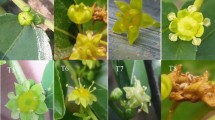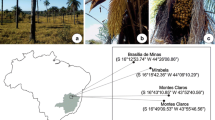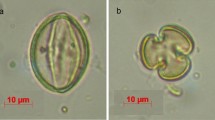Abstract
Gardenia jasminoides and Rosa chinensis are economically important horticultural plants in China. Frankliniella occidentalis and Thrips hawaiiensis are serious coexisting pests that previously demonstrated opposite population trends on G. jasminoides and R. chinensis flowers. To further study the different performances between F. occidentalis and T. hawaiiensis, we investigated their population dynamics in the field (for 5 years) and their life history characteristics on the two flowers in the laboratory. In the field, the density of F. occidentalis was lower than that of T. hawaiiensis on G. jasminoides but was higher than that of T. hawaiiensis on R. chinensis. Under laboratory conditions, F. occidentalis showed significantly slower development, and lower survival and fecundity levels than T. hawaiiensis on G. jasminoides, but the opposite was true on R. chinensis. Significant differences in the net reproductive rate (R 0) between F. occidentalis and T. hawaiiensis were observed, with respective values of 38.66 ± 2.85 and 47.91 ± 2.70 on G. jasminoides, and 55.64 ± 2.15 and 32.45 ± 2.16 on R. chinensis. The intrinsic rates of increase (r m ) of F. occidentalis and T. hawaiiensis were 0.156 ± 0.008 and 0.198 ± 0.007, respectively, on G. jasminoides, and 0.172 ± 0.003 and 0.165 ± 0.002, respectively, on R. chinensis. Thus, the performances of both thrips with respect to population size in the laboratory were in accordance with those in the field, suggesting that the innate capacity for insect population increases may directly impact their population dynamics in fields. Thus, the population performance of different thrips species on flowers is species-dependent, which could be exploited in thrips control programs by breeding pest-resistant cultivars.



Similar content being viewed by others
References
Aliakbarpour H, Salmah MRC (2011) Seasonal abundance and spatial distribution of larval and adult thrips (Thysanoptera) on weed host plants in mango orchards in Penang, Malaysia. Appl Entomol Zool 2:185–194
Atakan E, Uygur S (2005) Winter and spring abundance of Frankliniella spp. and Thrips tabaci Lindeman (Thysan., Thripidae) on weed host plants in turkey. J Appl Entomol 1:17–26
Atakan E, Ölçülü M, Pehlivan S, Satar S (2015) A new thrips species recorded in Turkey: Thrips hawaiiensis (Morgan, 1913) (Thysanoptera: Thripidae). Türk Entomol Bült 2:77–84
Bellows TS, Perring TM, Gill RJ, Headrick DH (1994) Description of a species of Bemisia (Homoptera: Aleyrodidae). Ann Entomol Soc Am 87:195–206
Birch LC (1948) The intrinsic rate of natural increase of an insect population. J Anim Ecol 17:15–26
Borbon CMD, Gracia OR (2006) Relationships between tospovirus incidence and thrips populations on tomato in Mendoza, Argentina. J Phytopathol 2:93–99
Brodbeck BV, Stavisky J, Funderburk JE, Andersen PC, Olson SM (2001) Flower nitrogen status and populations of Frankliniella occidentalis feeding on Lycopersicon esculentum. Entomol Exp Appl 2:165–172
Brødsgaard HF (1994) Effect of photoperiod on the bionomics of Frankliniella occidentalis (Pergande) (Thysanoptera, Thripidae). J Appl Entomol 117:498–507
Brown ASS, Simmonds MSJ, Blaney WM (2003) Relationship between nutritional composition of plant species and infestation levels of thrips. J Chem Ecol 12:2399–2409
Cao Y, Zhi JR, Cong CL, Margolies DC (2014) Olfactory cues used in host selection by Frankliniella occidentalis (Thysanoptera: Thripidae) in relation to host suitability. J Insect Behav 27:41–56
Cao Y, Liu Y, Xiong ZL, Wang C, Li C (2015) Oviposition preference of Frankliniella occidentalis to different horticultural host plants. Acta Phytopathol Sin 5:741–748
Chaisuekul C, Riley DG (2005) Host plant, temperature, and photoperiod effects on ovipositional preference of Frankliniella occidentalis and Frankliniella fusca (Thysanoptera: Thripidae). J Econ Entomol 6:2107–2113
Cheng MF (1985) Studies on morphology, life cycle and bionomics of the flower thrips, Thrips hawaiiensis (Morgan), on citrus. Natl China I Agric Inst Bull 12:43–55
Childers CC, Nakahara S (2006) Thysanoptera (thrips) within citrus orchards in Florida: species distribution, relative and seasonal abundance within trees, and species on vines and ground cover plants. J Insect Sci 6:1–19
Gao YL, Reitz SR (2017) Emerging themes in our understanding of species displacements. Annu Rev Entomol 62:165–183
Gaum WG, Giliomee JH, Pringle KL (1994) Life history and life tables of western flower thrips, Frankliniella occidentalis (Thysanoptera: Thripidae), on English cucumbers. Bull Entomol Res 84:219–224
Goldarazena A (2011) First record of Thrips hawaiiensis (Morgan, 1913) (Thysanoptera: Thripidae), an Asian pest thrips in Spain. Bull OEPP 41:170–173
Grover JP (1988) Dynamics of competition in a variable environment: experiments with two diatom species. Ecology 2:408–417
Huang Y, Cheng JS, Zhi JR, Yuan CM, Song QZ (2009) Investigation on thrips species on flowers in Guiyang, Guizhou Province. J Henan Agric Sci 6:93–96
Hulshof J, Ketoja E, Vanninen L (2003) Life history characteristics of Frankliniella occidentalis on cucumber leaves with and without supplemental food. Entomol Exp Appl 108:19–32
Kiers E, Kogel WJD, Balkema-Boomstra A, Mollema C (2000) Flower visitation and oviposition behavior of Frankliniella occidentalis (Thysan., Thripidae) on cucumber plants. J Appl Entomol 1:27–32
Kirk WDJ, Terry LI (2003) The spread of the western flower thrips Frankliniella occidentalis (Pergande). Agric For Entomol 4:301–310
Li WD, Zhang PJ, Zhang JM, Zhang ZJ, Huang F, Bei YW, Lin WC, Lu YB (2015) An evaluation of Frankliniella occidentalis (Thysanoptera: Thripidae) and Frankliniella intonsa (Thysanoptera: Thripidae) performance on different plant leaves based on life history characteristics. J Insect Sci 4:1–5
Liu SS, Barro PJD, Xu J, Luan JB, Zang LS, Ruan YM, Wang FH (2007) Asymmetric mating interactions drive widespread invasion and displacement in a whitefly. Science 318:1769–1778
Lowry VK, Smith JW, Mitchell FL (1992) Life-fertility tables for Frankliniella fusca (Hinds) and Frankliniella occidentalis (Pergande) (Thysanoptera: Thripidae) on peanut. Ann Entomol Soc Am 85:744–754
Lu YB, Zhang ZJ, Wu QJ, Du YZ, Zhang HR, Yu Y, Wang ED, Wang MH, Wang MQ, Tong XL, Lu LH, Tan XQ, Fu WD (2011) Research progress of the monitoring, forecast and sustainable management of invasive alien pest Frankliniella occidentalis in China. Chin J Appl Entomol 48:488–496
Mack RN, Simberloff D, Lonsdale WM, Bazzaz F (2000) Biotic invasions: causes, epidemiology, global consequences, and control. Ecol Appl 3:689–710
Mainali BP, Lim UT (2011) Behavioral response of western flower thrips to visual and olfactory cues. J Insect Behav 6:436–446
Manzari S, Golmohammadzadeh-Khiaban N (2000) Thrips hawaiiensis (Morgan, 1913), a new species for the thrips fauna of Iran. JESI 19:107–108
Mollema C, Cole RA (1996) Low aromatic amino acid concentrations in leaf proteins determine resistance to Frankliniella occidentalis in four vegetable crops. Entomol Exp Appl 78:325–333
Mooney HA, Cleland EE (2001) The evolutionary impact of invasive species. PNAS 98:5446–5451
Morse JG, Hoddle MS (2006) Invasion biology of thrips. Annu Rev Entomol 1:67–89
Mound LA (2005) Thysanoptera: diversity and interaction. Annu Rev Entomol 50:247–269
Mound LA, Kibby G (1998) Thysanoptera: an identification guide, 2nd edn. CAB International, Oxon
Murai T (2001) Development and reproductive capacity of Thrips hawaiiensis (Thysanoptera: Thripidae) and its potential as a major pest. Bull Entomol Res 91:193–198
Muvea AM, Meyhöfer R, Maniania NK, Poehling HM, Ekesi S, Subramanian S (2015) Behavioral responses of Thrips tabaci Lindeman to endophyte-inoculated onion plants. J Pest Sci 88(3):555–562
Nielsen MC, Teulon DAJ, Chapman RB, Butler RC, Drayton GM, Philipsen H (2010) Comparison of life history parameters of two Frankliniella occidentalis (Thysanoptera: Thripidae) strains in new zealand. Environ Entomol 2:303–311
Northfield TD, Paini DR, Funderburk JE, Reitz SR (2008) Cycles of Frankliniella spp. thrips abundance on north Florida uncultivated reproductive hosts: predicting possible sources of pest outbreaks. Ann Entomol Soc Am 101:769–778
Northfield TD, Paini DR, Reitz SR, Funderburk JE (2011) Within plant interspecific competition does not limit the highly invasive thrips, Frankliniella occidentalis in Florida. Ecol Entomol 36:181–187
Paini DR, Funderburk JE, Jackson CT, Reitz SR (2007) Reproduction of four thrips species (Thysanoptera: Thripidae) on uncultivated hosts. J Entomol Sci 42:610–615
Paini DR, Funderburk JE, Reitz SR (2008) Competitive exclusion of a worldwide invasive pest by a native. Quantifying competition between two phytophagous insects on two host plant species. J Anim Ecol 77:184–190
Reitz SR (2009) Biology and ecology of the western flower thrips (Thysanoptera: Thripidae): the making of a pest. Fla Entomol 1:7–13
Reitz SR, Yearby EL, Funderburk JJ, Momol MT, Olson SM (2003) Integrated management tactics for Frankliniella thrips (Thysanoptera: Thripidae) in field-grown pepper. J Econ Entomol 4:1201–1214
Reitz SR, Gao YL, Lei ZR (2011) Thrips: pests of concern to China and the United States. Agric Sci China 10:867–892
Reynaud P, Balmès V, Pizzol J (2008) Thrips hawaiiensis (Morgan, 1913) (Thysanoptera: Thripidae), an Asian pest thrips now established in Europe. Bull OEPP 1:155–160
Richard OW (1961) The theoretical and practical study of natural insect populations. Annu Rev Entomol 6:147–162
Riffell JA, Shlizerman E, Sanders E, Abrell L, Medina B (2014) Flower discrimination by pollinators in a dynamic chemical environment. Science 344:1515–1518
Riley DG, Chitturi A, Sparks AN (2007) Does natural deposition of pine pollen affect the ovipositional behavior of Frankliniella occidentalis and Frankliniella fusca (Thysanoptera: Thripidae)? Biomed Eng Biomed Tech 1:133–141
Riley DG, Angelella GM, McPherson RM (2011) Pine pollen dehiscence relative to thrips population dynamics. Entomol Exp Appl 138:223–233
Soria C, Mollema C (1995) Life-history parameters of western flower thrips on susceptible and resistant cucumber genotypes. Entomol Exp Appl 74:177–184
Southwood TRE, Henderson PA (2000) Ecological methods, 3rd edn. Blackwell Science, Oxford
Teulon DAJ, Hollister B, Butler RC, Cameron EA (1999) Colour and odour responses of flying western flower thrips: wind tunnel and greenhouse experiments. Entomol Exp Appl 1:9–19
Trichilo PJ, Leigh TF (1988) Influence of resource quality on the reproductive fitness of flower thrips (Thysanoptera: Thripidae). Ann Entomol Soc Am 81:64–71
van Rijn PCJ, Mollema C, Steenhuis-Broers GM (1995) Comparative life history studies of Frankliniella occidentalis and Thrips tabaci (Thysanoptera: Thripidae) on cucumber. Bull Entomol Res 85:285–297
Varley GC, Gradwell GR (1970) Recent advance in insect population dynamics. Annu Rev Entomol 15:1–24
Vernon RS, Gillespie DR (1990) Spectral responsiveness of Frankliniella occidentalis (Thysanoptera: Thripidae) determined by trap catches in greenhouses. Environ Entomol 5:1229–1241
Wang KG, Yi H, Lei ZR, Xiang JC, Lian ZM (2013) Surveys and analysis of competition and displacement between two invasive species of leafminer fly in Hainan province. Agric Sci China 22:4842–4848
Wang SY, Qi YF, Desneux N, Shi XY, Biondi A, Gao XW (2016a) Sublethal and transgenerational effects of short-term and chronic exposures to the neonicotinoid nitenpyram on the cotton aphid Aphis gossypii. J Pest Sci 2:1–8
Wang ZH, Gong YJ, Jin GH, Li BY, Chen JC, Kang ZJ, Zhu L, Gao YL, Reitz S, Wei SJ (2016b) Field-evolved resistance to insecticides in the invasive western flower thrips Frankliniella occidentalis (Pergande) (Thysanoptera: Thripidae) in China. Pest Manag Sci 7:1440–1444
Whitfield AE, Ullman DE, German TL (2005) Tospovirus–thrips interactions. Annu Rev Phytopathol 43:459–489
Wu Y, Liu K, Qiu H, Li FJ, Cao Y (2014) Polymorphic microsatellite markers in Thrips hawaiiensis (Thysanoptera: Thripidae). Appl Entomol Zool 4:619–622
Yuan CM, Zhi JR, Li JZ, Zhang Y (2008) Investigation on the species of thrips in fields of vegetable in Guizhou Province. China Plant Prot 7:8–10
Yuan CM, Zhi JR, Zheng SS, Huang Y (2010) Investigation of damage of Frankliniella occidentalis in Guiyang. J Southwest China Norm Univ (Nat Sci Ed) 1:142–145
Zhang YJ, Wu QJ, Xu BY, Zhu GR (2003) The occurrence and damage of Frankliniella occidentalis (Thysanoptera: Thripidae): a dangerous alien invasive pest in Beijing. Plant Prot 4:58–59
Zhang ZJ, Wu QJ, Li XF, Zhang YJ, Xu BY, Zhu GR (2007) Life history of western flower thrips, Frankliniella occidentalis (Thysan., Thripidae), on five different vegetable leaves. J Appl Entomol 5:347–354
Zhi JR, Fitch GK, Margolies DC, Nechols JR (2005) Apple pollen as a supplemental food for the western flower thrips, Frankliniella occidentalis: response of individuals and populations. Entomol Exp Appl 117:185–192
Acknowledgements
We thank the Provincial Key and Special Subject of Guizhou Province—Ecology (No. ZDXK[2015]11) and the Training Project for High-Level Innovative Talents in Guizhou Province (No. 2016 [4020]) for financial support.
Author information
Authors and Affiliations
Corresponding authors
Ethics declarations
Conflict of interest
The authors declare that they have no conflict of interest.
Human and animal rights
This research did not involve any human participants and/or animals, only the flower thrips F. occidentalis and T. hawaiiensis.
Informed consent
Not applicable.
Additional information
Communicated by M. Traugott.
Rights and permissions
About this article
Cite this article
Cao, Y., Zhi, J., Zhang, R. et al. Different population performances of Frankliniella occidentalis and Thrips hawaiiensis on flowers of two horticultural plants. J Pest Sci 91, 79–91 (2018). https://doi.org/10.1007/s10340-017-0887-3
Received:
Revised:
Accepted:
Published:
Issue Date:
DOI: https://doi.org/10.1007/s10340-017-0887-3




